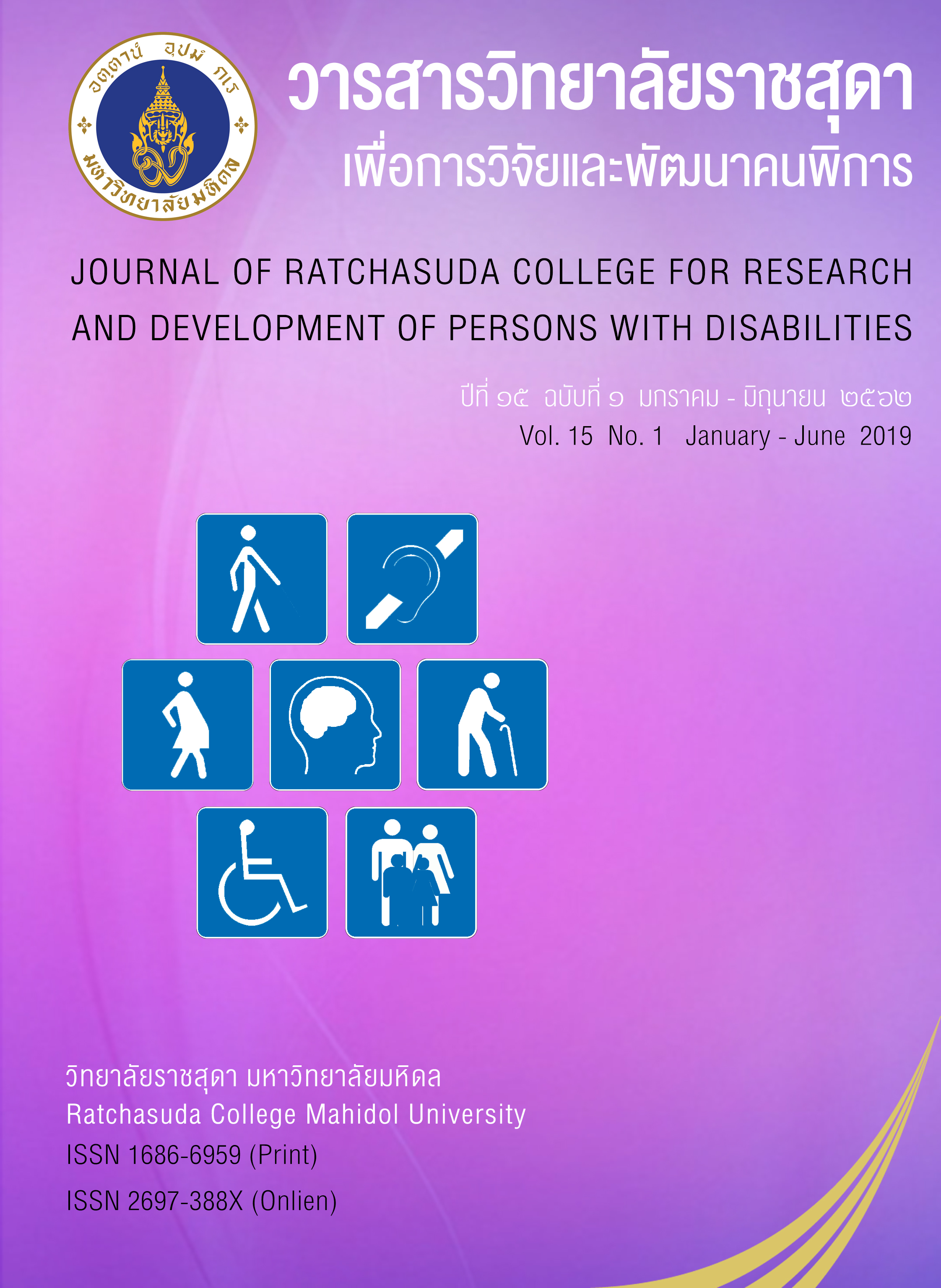Expectation; problems and obstacles of employers to disabled person’s employment according to the act of Promotion and Development of Quality of Life for Disabled Persons Act B.E. 2550 (2007) and the 2nd edit B.E. 2556 (2013)
Keywords:
Disabled, Employment, Employer, Problems and Obstacles of EmploymentAbstract
The purposes of “Expectation; problems and obstacles of employers to disabled The purposes of “Expectation; problems and obstacles of employers to disabled person’s employment according to the act of Promotion and Development of Quality of Life for Disabled Persons Act B.E. 2550 (2007) (Empowerment of Persons With Disabilities Act, 2007) and the 2 nd edit B.E. 2556 (2013) (Department of Empowerment of Person with Disabilities, 2013)” were to: 1) study levels of expectations of employers towards the disability employment in businesses; and 2) study levels of problems and obstacles of disability employment in businesses. This research was a quantitative research. The sample group consisted of representatives of 148 businesses which were employers hiring the disabled. The findings revealed that the majority of sample group working in the human resources department (96.6%) and service business (23%). The knowledge on the Promotion and Development of Quality of life of Persons with Disabilities Act was at moderate level (58.8%). The people with mobility disabilities were mostly hired (67.6%). Apart from the disability employment, the majority of businesses had other policies (91.2%) including spaces for goods or services sale (54%) and facilities provision (52%). The facilities mostly provided for the disabled were ramp and transportation (16.7%). And, the job position was clerk/ administrator (32.7%). For the levels of expectations of employers towards the employees with disabilities, it was found that the overall expectation was at high level The most expected aspect was working behavior as the sample group had expectations at high level, while the least expected aspect was the benefits earned by employers as the expectation level was at moderate. Besides, the study on level of problems and obstacles of disability employment was at moderate. For each aspect, the most problems and obstacles were public relation of authorities relevant to the Disability Employment under the Promotion and Development of Quality of life of Persons with Disabilities Act, B.E. 2550 (2007) (Empowerment of Persons With Disabilities Act, 2007) and the 2 nd edit B.E. 2556 (2013) (Department of Empowerment of Person with Disabilities, 2013). The opinion that authorities did not disseminate information adequately was at moderate level. The least problems and obstacles were that the disabled were unable to work on their own and became burden of colleagues as the opinion was at low level.
Downloads
References
Chanyaankul, S. (2013). “Put the right man on the right job” Disability labor exit. Retrieved on 21 January 2016 from http://www.bluerollingdot.org/articles/scoop/215
Chuesuwantavee, T., Kiratiphanthawong, S., Chanphong, P., Utchawathi. R., Thitisaploet, C., & Nisecorp S.E. Co., Ltd. (2015). Appropriate Opportunity for Disability. Nakhon Pathom: Ratchasuda
College, Mahidol University.
Daily News. (2016). Au ordered to seize assets of 44 company refused to hire disable persons. Retrievedd on 29 January 2016 from http://www.dailynews.co.th/politics/373417
Department of Empowerment of Person with Disabilities. (2013). Law Compliance for Disable Person Employment 2014. Retrieved on 20 January 2016 from http://nep.go.th/th/news
Division of Persons with Disabilities Fund and Equality Promotion, Department of Empowerment of Person with Disabilities. (2015). Promotion of Disabled Employment in Establishment.
Retrieved on 3 February 2016 from http://nep.go.th/sites/default/files/files/document/10-9-58.pdf
Empowerment of Persons With Disabilities Act, B.E. 2550 (2007). Retrieved on 20 January 2016 from http://law.m-society.go.th/law2016/law/view/551
Kanjanajittra, S., Jhermpun, S., & Janjaroen, K. (2013). Career Promotion and Employment of Disabled according to Empowerment of Persons With Disabilities Act, B.E. 2550. National Office for
Empowerment of Persons with Disabilities, Ministry of Social Development and Human Security
Manager Online. (2014). Department of Labor discussed with the establishment to retain the proportion of normal person 100:1 disabled. Retrieved on 22 January 2016 from http://
www.manager.co.th/QOL/ViewNews.aspx?NewsID=9570000104452
Mongkolsawadi, S. (2000). Promotion of employment for people with disabilities. Thesis of Master of social Work. Huachiew Chalermprakiet University.
National Statistical Office. (2014). Disabilities Survey B.E. 2555. Bangkok: Text and Journal Publication Co., Ltd.
Phanwilai, K. (2003). Trend of Disabled Enrolment in Chiang Mai Establishment. Thesis of Master of Education. Chiang Mai University.
Rasrichan, P. (2015). Problems and guidelines in adjusting the employment of disabled people according to the promotion and quality of life development of the disabled act 2007: a case study of Chon Buri city, Chon Buri. Thesis of Master of public and private management. Graduate School of Public Administration. Burapha University.
Tawangthan, A. (2011). Attitude Towards Motivation on Disabled Employment in Establishment. Thesis of Master of Social Administration. Thammasat University.
The Federation of Thai Industries. (2015). Promotion of Disabled Employment in Industry.Bangkok: The Federation of Thai Industries.
Wuttikorn, K. (2009). Monitoring Disabled Work Performance in Establishment in Bangkok. Master of Social Administration. Thammasat University.
Downloads
Published
How to Cite
Issue
Section
License
บทความที่ได้รับการตีพิมพ์เป็นลิขสิทธิ์ของวารสารสถาบันราชสุดาเพื่อการวิจัยและพัฒนาคนพิการ






